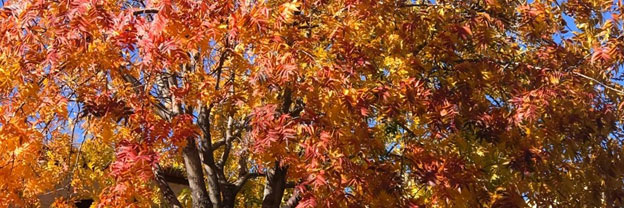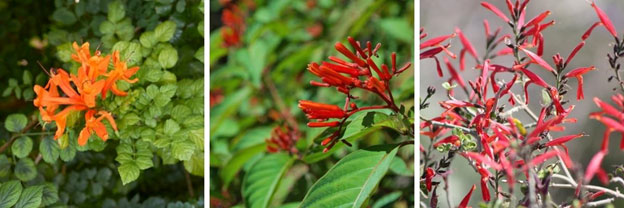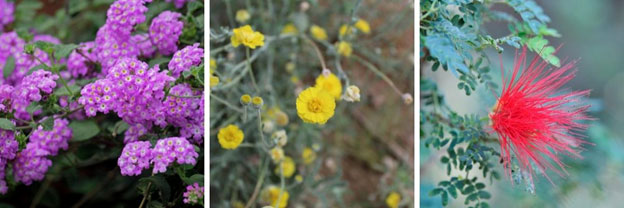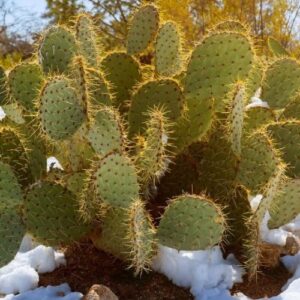
In other climates, the term “winter interest” often applies to trees with peeling bark, red berries that pop against white snow, or flowers that dry out and create compelling shapes in the landscape.
In the Phoenix and Anthem areas, however, it can refer to almost any tree, plant, shrub, cactus, or palm.
To narrow it down, we will focus on some trees, shrubs, plants, and wildflowers that provide color or distinction, or may otherwise catch your eye during the winter months.
Trees for Winter Interest

Changing Leaves
We’ve already talked about how “fall” color usually reaches Phoenix during the winter months. (You can read more about that in this article). Red, orange, yellow, and even some green leaves cover the trees in the Phoenix and Anthem areas during the winter months.
One tree that demonstrates this very late “fall” color is the Red Push Pistache (Pistacia ‘Red Push’). This hybrid pistachio tree does not produce any kind of nut or seed, but it does have vibrant leaves that change from red to orange. While considered an ornamental tree, it can grow quite large and can provide shade during the hot summer months. (Note: this tree is NOT on the Anthem Approved Plant List)
Some other trees that provide winter interest include:

Sweet Acacia (Acacia smallii)
The sweet acacia tree has small, yellow, fluffy circular flowers that appear in late winter or early spring. These fragrant puffballs make the sweet acacia a popular landscape tree on residential and commercial properties throughout the southwest.

Citrus Trees
Citrus trees, such as orange, grapefruit, tangelo, and lemon trees, are popular in some Phoenix suburbs, though they are not allowed everywhere.
Not only do they produce edible fruit, but their fragrant white blooms will begin appearing in February or March.

Palm “Trees”
Nothing makes you forget it is winter like the sight of a palm! Though technically they are in the grass family, palm “trees” can add some color and life to a property all year long.
Shrubs, Plants, and Flowers for Winter Interest
There are many shrubs, plants, and wildflowers that can add a pop of color to your property during the winter months. We covered a few of them, such as the fairy duster and chuparosa, in more detail in our article on spring-flowering shrubs. Below are our suggestions for plants that bloom between late fall and spring and are easy to maintain. Many are native plants that support a wide range of pollinators.

Black Dalea (Dalea frutescens) – The purple flowers on this low-growing shrub bring a pop of late fall color and attract pollinators to your yard.
Emu Bush or Valentine Bush (Ermophila glabra) – The aptly named Valentine bush is usually covered with bright pink flowers in time for Valentine’s Day. Growing 3 to 4 feet tall and wide, with small dark green leaves, this evergreen shrub is easy to fit into almost any garden where you want a burst of color through the winter months.
Carolina Jasmine (Gelsemium sempervirens) – The cup-shaped yellow flowers on the Carolina Jasmine (or Carolina Jessamine) vine bloom from January through April. They stand out beautifully against the deep green leaves of this moderately fast growing evergreen vine. It looks beautiful all year on a trellis, arbor, fence, or wall, and can also be allowed to sprawl as a ground cover.

Firecracker Penstemon (Penstemon eatonii) – The tubular bright red flowers attract hummingbirds. Another good option is Parry’s penstemon (Penstemon parryi) which has vibrant pink blossoms.
Aloe – Aloe plants are succulents that put up flower spikes in winter and spring. Most have tubular orange or red blossoms, although some have yellow flowers. These plants spread quickly and need room to grow, although they can also be planted in containers if they’re regularly thinned.
Regal Mist Muhly Grass (Muhlenbergia capillaris) – In our part of the country, this mounded grass has pink flowers in the fall and into winter (farther north, it blooms in summer and fall). Pink muhly grass makes a beautiful statement in the winter landscape as its delicate pink stems gently wave in the breeze.

Lady Banks’ Rose (Rosa banksiae) – This trailing rose does extremely well in the desert climate, scrambling up walls and fences, and putting out masses of yellow or white flowers almost all year.
Autumn Sage (Salvia greggii) – Available in a variety of colors, this drought-tolerant plant can grow up to 3 feet wide and tall. Colors include red, pink, and purple. The autumn sage plants attract hummingbirds and appreciate full sun.
Texas Mountain Laurel (Sophora secundiflora) – The purple flowers are not only beautiful, but they also smell like grape soda or grape bubblegum. This shrub can be pruned into a tree, but be careful not to overprune as it is a slow-growing plant.

Cape Honeysuckle (Tecoma capensis) – This shrub can be easily grown as a vine. As a shrub, it can reach 7 to 10 feet high and wide, as a vine, it can reach heights of 25 to 30 feet.The leaves stay green all year and the fragrance-free orange flowers are tubular and attracts hummingbirds and butterflies. It is not a true honeysuckle, but rather a member of the trumpet creeper family. It is native to South Africa.
Mexican Honeysuckle (Justicia spicigera) – Also known as the firecracker plant, it has some similarities to the cape honeysuckle, but is native to Mexico. It can grow to 3 to 5 feet high and wide, and has orange tubular flowers. It prefers full sun to partial shade and does not do well in caliche soil. It can sometimes be confused with chuparosa.
Chuparosa (Justicia californica) – Another plant with orange-red tubular flowers, chuparosa is native to Arizona, California, and Mexico. It doesn’t need a lot of water and loves the sun. Like other tubular plants, it attracts hummingbirds. The plant will drop its leaves during the summer, using the green stems for photosynthesis while conserving energy.

Bougainvillea (left and center photo) – This large, sprawling vine with colorful bracts (although they’re not flowers, most people refer to them that way) has varieties in a number of colors and even some with variegated leaves. The most popular colors are shades of red and pink.
Lantana (Lantana aculeata) – This low-to-the-ground-shrub makes an excellent groundcover. Some types are considered dwarf of mounding varieties, usually found in shades of red, gold, and pink. Other varieties are considered bushes and are usually orange or pink. Note that some varieties will drop their leaves in cold weather, whereas the trailing lantana (below) is evergreen.

Trailing Lantana (Lantana montevidensis) – This low growing, spreading variety of lantana is usually found in shades of purple, yellow, or white. They stay evergreen throughout the winter.
Desert Marigold (Baileya multiradata) – You may spot varieties of this short-lived perennial when you are out hiking in our local desert. It doesn’t like “wet feet” so be sure not to overwater it.
Baja Fairy Duster (Calliandra californica) – A thornless shrub that works well in the Phoenix area. It can grow to 5 feet high and wide and has unique small red blooms that appear almost fluffy, hence its name. It is native to Baja California and requires little water. The flowers can appear year-round.
Choose Frost-Tolerant Plants
Average winter temperatures in the greater Phoenix area rarely dip below the 40’s. But, while the chance of frost damage in the greater Phoenix area is slim, it’s still possible.
Check out this article on how to protect your plants from winter cold damage.
Choosing plants that are frost tolerant is a simple way to prevent much of the damage. But when frigid temperatures are forecasted, you may want to cover your more tender plants with old sheets, blankets, or frost cloth to avoid unsightly frost damage.
Winter in Phoenix
Fluctuating night and day temperatures, some winter rain, and mostly sunny days summarizes the winter weather in Phoenix. With our milder weather and abundance of sunshine, many plants and trees thrive here that would wither anywhere else.
We hope this list of trees, plants, and flowers has given you some ideas for increasing the color and variety of plants in your own Phoenix-area yard. You can always contact the experts at Titan Tree Care if you have any questions about your own trees or shrubs, tree planting, or tree maintenance.
See Our Latest Articles
More Articles Like This

Titan Tree Care is a full-service tree care company located in Anthem, AZ and serving all of North Phoenix. We offer a wide range of services to meet your tree care needs, including tree and palm trimming, tree pruning, tree removal, stump grinding, and more. We also offer insect or disease treatments and fertilization services. We are dedicated to providing high-quality, safe, and effective tree care services to our customers and work hard to ensure that your trees are healthy and look their best.









